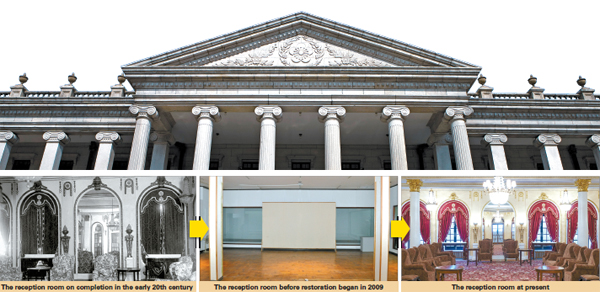Seokjojeon’s rebirth resurrects a dark era

Seokjojeon at Deoksu Palace, central Seoul, will open to the public next Monday. By Kwon Hyuk-jae
The late 19th-century structure’s revamp involved more than just sprucing up the architecture. The interior also needed work, meaning that furniture, bedding and other home items from the period were bought or reproduced based on historical materials.
The Cultural Heritage Administration (CHA) allowed Korean journalists an exclusive look at the storied structure yesterday, ahead of its opening as the Daehan Empire History Museum on Oct. 13.
The Daehan Empire (1897-1910) has been overlooked as a short-lived, unfortunate era sandwiched between the Joseon Dynasty (1392-1910) and Japanese colonization (1910-45).

The stairway, above, leads to the empress’s bed chamber, left, and the emperor’s bed chamber. In the end, these rooms were never used by King Gojong and his wife, Princess Consort Sunheon (1854-1911). They were, however, used by Crown Prince Yeongchin (1897-1970) - Gojong’s son and the last crown prince of the Korean Empire - and his wife when they were in Korea. However, both spent most of their lives in Japan. By Kwon Hyuk-jae
Foreign influence on Korea during the era becomes evident when studying how Seokjojeon came into being.
The idea for the three-story, neo-Classical structure in the northwestern part of the Deoksu Palace grounds was raised by John McLeavy Brown (1835-1926) - Ireland-born financial advisor and chief commissioner of customs in Korea - in 1897, the year that the empire was declared. The building was designed by a British architect named John Reginald Harding.
Coincidently, the structure was completed in 1910, when the Japanese colonization began. Only two months after Seokjojeon was ready to be used by Korea’s imperial family, the nation was forced to sign the Japan-Korea Annexation Treaty.
During colonization, the building was used as an art museum.
Historians and architects worked together to cull photographs, documents, dissertations and catalogues related to Seokjojeon at home and abroad - mostly in the United Kingdom and Japan - to recreate the emperor and empress’s bedrooms, dining rooms and reception rooms, among others.
The basement, however, could not be restored as it was used by court servants, so there is no historical record of what it used to look like.
“Color was the most difficult part in the restoration process because most of the materials we used were black and white,” said Ahn Chang-mo, a professor of architecture at Kyonggi University. “We had no option but to resort to other modern buildings of that time period.”
Ahn, who oversaw the restoration process, specializes in late 19th- to early 20th-century Korean architecture.
Nine fireplaces have been restored in the building while chimneys were also reconstructed. A total 133 pieces of furniture have been positioned to look like they did when they were first built. Forty-one are from the period, mostly from the National Palace Museum of Korea, while 79 were bought through antique stores in the United Kingdom as the British company Maple provided furniture to Seokjojeon and 13 were reproduced by artisans.
While some critics question why so much tax money was spent on recreating a foreign-looking structure, the government says the building reflects the efforts of late 19th-century Korea to remain a sovereign state while also marking its rebirth as a modern country open to new ideas from the West.
The period in which Seokjojeon was built - the short-lived Daehan Empire - is considered one of the darkest and most desperate in Korea’s modern history. The Joseon Dynasty unsuccessfully declared the start of a new kingdom amid increasing pressure from Japanese imperialists.
However, in the last decade or so, some historians claimed that the Daehan Empire wasn’t as powerless or incompetent as generally thought. Seokjojeon, historians argue, is a positive example of the unfortunate former territory’s achievements.
“The Daehan Empire is often viewed negatively by Koreans, but it was part of the big course of the history,” said Lee Min-won, an adviser to the restoration project.
BY KIM HYUNG-EUN [hkim@joongang.co.kr]










with the Korea JoongAng Daily
To write comments, please log in to one of the accounts.
Standards Board Policy (0/250자)